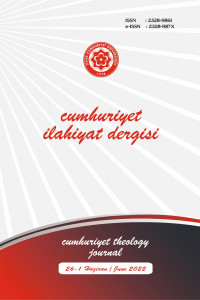Orta Çağ Batı Hıristiyan Manastırlarında (6-12. yy.) Manevi Okuma Kültürü: Lectio Divina
Spiritual Reading Culture in Medieval Western Christian Monasticism (c. 6-12.): Lectio Divina
Author(s): Yasin GüzeldalSubject(s): Christian Theology and Religion, Library operations and management, 6th to 12th Centuries, History of Religion
Published by: Cumhuriyet Üniversitesi İlahyat Fakültesi
Keywords: History of Religion; Christianity; Scripture; Monastic Life; Lectio Divina;
Summary/Abstract: Lectio divina is a culture of reading, which has its roots in the early centuries of the church, and specifically refers to the contemplative reading of the Bible. The lectio has become one of the indispensable elements of monasteries, with the transition from the early desert monasteries, where reading outside the Bible was not given much importance, to the settled monastic order. Because the ultimate goal in monasteries is to be one with God. Lectio divina is also a practice that helps the monk to reveal the spiritual meaning of the scriptures that will lead him to the goal in this journey. Lectio divina’s entry into monastic literature dates back to St. Benedict (d. 547), who included it in the daily monastic calendar as a kind of monastic discipline. Saint Benedict has included some regulations in the Benedictine Rule, which is the monastic statute he wrote, that will enable the monks to perform lectio divina both in offices and when they are not busy with manual work (Regula Benedicti, 48). However, lectio divina means firstly the reading of the Bible and also reading the works of the church fathers. Over time, this situation developed in monastic circles as a trio of reading, meditation, and prayer (lectio, meditatio, oratio). Because the purpose of reading mentioned here is not to acquire knowledge, but to internalise the meaning of the text read. In the study, some questions regarding the content of the lectio divina practice, which was started to be practiced regularly in monasteries with Saint Benedict, the time allocated to it in the daily program and how it should be practiced, were answered. While the lectio divina is a useful way to study the Bible, it is not synonymous with Bible studies. Thus, while Bible studies require looking at the Bible as a whole and interpreting it by asking questions and occasionally doing research, the lectio divina requires a special focus on a short section of the Bible. What should be understood from this prayer-oriented approach is that reading can be in the form of a chapter, a passage, or even just a word. Because lectio divina means a meaning that carries reading to a spiritual dimension. For this reason, in this research, it has been tried to explain that it is an application beyond reading an ordinary text, with special emphasis on the spiritual aspect of lectio divina. The ideal of the monastery school, which Magnus Aurelius Cassiodorus (d. 583), who was a contemporary of Saint Benedict, thought that religious and mental sciences could be taught together, is important. In addition, in the study, information was given about the monastery copying activities and the copied works, which have an important place to be directly related to the lectio and ensuring the preservation of knowledge and transferring it to the next generations. Because, with introducing lectio divina into the monastic literature, the reading of works other than the Bible and religious books came to the fore. From this point of view, it has been tried to explain the comments made by the monastic leaders from the early period to the 12th century about the pagan literature, which is not included in the works read in the monastic libraries, how the attitude was towards these works, and the reasons why they approached these texts positively or negatively. Lectio divina gradually gained popularity among monasteries affiliated with the Roman Catholic Church, and by the 12th century it had evolved into the four-stage reading process known today by Guigo II (d. 1188). It is understood that a different type of mental activity is applied at each stage of these four steps, which comprise reading, meditation, prayer and contemplation. For this reason, it has been tried to explain how this four-step analogy, in which Guigo II describes the readings of the sacred texts in a metaphorical style, influences the practice of lectio. In addition, the views of Bernard of Clairvaux (d. 1153), one of the other important religious figures of the 12th century, who had a similar style to Guigo II, about lectio were discussed and the relationship between this practice and meditation was tried to be explained. Indeed, by people like Bernard of Clairvaux, the lectio came to be seen as a guide through the various stages of the soul's union with God. In our country, no independent or indirect study has been found about lectio divina. In the research, information will be given about the development of the lectio divina in the historical process, its content, its place in the monastic literature and the way it is applied. It is thought that this research will arouse interest and curiosity to show the importance given to the mystical dimension of Bible readings or other spiritual readings.
Journal: Cumhuriyet İlahiyat Dergisi
- Issue Year: 26/2022
- Issue No: 1
- Page Range: 251-267
- Page Count: 17
- Language: Turkish

